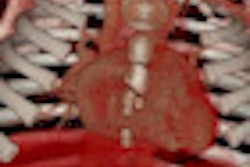VIENNA - Two studies of clinical CT doses in Europe -- one that compared Malta with data from several other countries and a second study from Norway -- showed that while dose variations remain wide on the continent, there are opportunities for substantial improvement with dose-reduction training and programs. The two studies were presented back-to-back on Saturday at the European Congress of Radiology (ECR).
In the first study, Ph.D. student Frank Zarb and colleagues from the University of Malta and co-investigators at University College Dublin in Ireland surveyed CT data in Malta that included more than half of all public and private hospitals. They compared the frequency of common CT exams with frequency in other European countries.
The latest dose DATAmed numbers from 10 European countries show that CT exams comprise 8.5% of all ionizing radiation exams in Malta, Zarb said, with numbers in other countries "ranging from 4.5% in Denmark to 14% in Luxembourg," he said. Still, the 8.85% figure represents a reduction from prior years on the island.
DATAmed is a research project of the European Commission involving the National Institutes of Statistics.
Other countries included Norway, with CT at 7% of all ionizing radiation exams; Germany, U.K., and New Zealand at 4%; and Spain and Sweden at 3%, he said.
The exam data reported in the survey represented three different CT manufacturers and four different models. The group modified European guidelines representing categorization of CT exams to enable international comparison of exam frequencies.
"We used a broad categorization of studies in order to be able to compare different CT units, and also to compare them with other countries," Zarb said. The questionnaire data were obtained from the RIS networks of participating medical centers, and the authors achieved a 57% participation rate in Malta, he said.
The researchers estimated the collective dose by using the European average effective dose multiplied by the number of persons exposed within the population, totaling 23,458 man-Sv (man-Sieverts, or collective effective dose commitment) for the head, 54,833 man-Sv for the abdomen and pelvis, and 10,616 man-Sv for CT of the thorax, Zarb reported.
In Malta, CT exams of the head were indicated as the most frequent, at 43% of all CT exams, followed by abdomen and pelvis exams at 38%, numbers that were in line with other countries in the survey.
|
"From these results, CT examination of the head, CT examination of the abdomen and pelvis, and CT exams of the thorax were identified as three of the most requested CT examinations in Malta," Zarb said. "We could now target the establishment of diagnostic reference levels in these examinations."
CT is a cause of concern due to its high radiation dose, so identifying the most frequently requested exams is important for targeting optimization strategies for CT scanning protocols to establish diagnostic reference levels that will enable patient dose reductions that will still allow the same diagnostic efficacy, he said.
Lower radiation levels in Norway's collaborative centers
Wide dose variations have been reported in CT, leading Reidun Silkoset and colleagues at Oslo University College to undertake a study of CT doses for common procedures.
Their study sought to assess the doses associated with standard CT procedures in Norway, as well as to determine associations that would predict the radiation dose for a given exam.
"In Norway, the frequency [of CT exams] doubled between 1993 and 2002" Silkoset said in her ECR presentation. "CT accounts for approximately 60% of the collective effective dose but only 11% of all exams examinations."
The need for more knowledge about CT doses stems from the continuously increasing number -- a general trend not just in Norway but in all developed countries, she said.
The researchers obtained local diagnostic reference levels (DRL) for CT of the head and abdomen from 22 different facilities in Norway. They developed a questionnaire to examine dose variations reflecting the organization and performance of the diagnostic work. The group hoped to explain whether these substantial variations could be explained by dose optimization efforts by the facilities.
"We limited the study to CT head, which is the most common examination, and CT abdomen, which is the exam using the highest doses," she said. The Norwegian Radiation Protection Authority was responsible for the dose data collection.
The local diagnostic reference level dose-length product (DLP) varied by a factor of four for the head and three for the abdomen, Silkoset said.
Results showed that the DLP for CT head exams varied from 494 to 1,781 mGy-cm, with 900 mGy-cm as the mean value. The results are comparable to other studies from Europe, she said.
For CT abdomen, the DLP varied from 243 to 1,000 mGy-cm with an average value of 550 mGy-cm. "This represents a variation in the effective dose between 4 and 15 mSv, with 8 mSv as the mean value," Silkoset said.
A multitude of factors affect CT doses," she said, adding that the various factors are also interrelated, making their correlation to dose levels an extremely complex question. "However, our findings of associations between certain optimization factors and doses do provide indications for possible reasons for the variations," Silkoset said.
Importantly, the mean DLP value was 35% lower in facilities where the managing radiographer had undergone postgraduate studies in CT, compared to facilities in which the radiographer did not have this educational background.
Regarding scan technique, doses were 25% lower in facilities using axial scans rather than helical scans, she said, probably because the scan ranges were necessarily longer in some helical scan acquisition models.
In addition, facilities that developed their own protocols had significantly lower CT doses, both for head and abdominal scans, compared to those that relied on manufacturers' recommended doses, she said.
Facilities that used phantom models for quality control in addition to developing their own protocols cut approximately an additional 20% from their head and abdominal doses, according to a chart Silkoset provided in her presentation.
Finally, working in multidisciplinary teams that included radiographers and medical physicists reduced average doses, she said.
"We found substantial variations in CT doses," she said. "CT doses can probably be reduced by increased effort in optimization work." Multidisciplinary collaboration has an important role to play in CT dose reduction, and local DRL is an important tool for measuring the results.
By Eric Barnes
AuntMinnie.com staff writer
March 6, 2010
Related Reading
Radiation exposure increases risk of breast cancer, March 4, 2010
High pitch equals low dose in coronary CT angiography, March 4, 2010
320-row CT minimizes dose in pediatric abdominal studies, March 3, 2010
NIH tells scanner suppliers to include radiation monitoring, February 1, 2010
Controversy can't alter facts: Screening mammography has proven benefits, December 2, 2009
Copyright © 2010 AuntMinnie.com




















